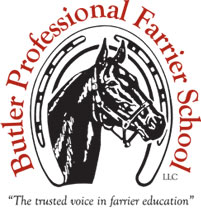Older books defined quittor as simply an infection in the horse’s foot that could take on several different forms: cutaneous quittor (skin and underlying tissue), tendinous quittor (infection extending to tendons and ligaments), cartilaginous quittor (deeper infection in the lateral ungular cartilages), and sub-horny quittor (within the hoof). (Axe, J.W. The Horse: Its Treatment in […]
When it comes to diseases of the horse’s foot, keratoma is not as scary as it sounds. Literally, keratoma means a tumor (-oma) in the hoof wall (keratin). Tumor can sound intimidating, but most of the time these growths are benign and don’t cause pain. In instances where the horse is sound and does not […]
Trimming and shoeing a horse’s foot can be a stressful experience to the careful beginner. No one wants to intentionally harm the horse. In order to gain more confidence about trimming the hoof, a farrier must learn what is inside the foot. Just like any good mechanic understands what is under the hood of the car […]
Horses have a unique skeletal structure that is highly developed at birth (compared to other species). A young foal can run with a herd within hours after birth. The skeleton creates the framework for the body to function. Or as my 6 year old daughter explained to me, “Without a skeleton, we’d all just be […]
The horse’s foot is a bio-mechanical marvel with many parts. Each part has a function. One of the most interesting parts is the frog. The frog is an insensitive, wedge shaped cushion or pad that helps the horse with shock absorption, traction and circulation. It is also a scent gland. The exact etymology of how […]
The navicular bone in the foot of the horse is known more for the problems it can create (i.e. navicular syndrome) rather than for its actual function. Navicular syndrome or navicular disease often results in heel pain due to a problem associated with the navicular region; not just the bone. The condition is usually treated […]
When inspecting a horse’s feet, it can be alarming to see red marks on the outer hoof wall and on the sole. Some owners and beginning farriers might even mistake these red spots for fresh blood! However, most of these spots are remnants of past injuries known as bruises. They are simply evidence of an […]
Tendon injuries can be devasting and career-ending for horses, depending on the severity of the damage and the availability of a knowledgeable veterinarian/farrier team. Horses have four major tendons in their lower legs. There are two extensor tendons in the front (common extensor and lateral extensor) and two flexor tendons in the back (superficial digital […]
Hoof wall thicknesses vary. There is a very small margin for error. The farrier must pay close attention to selecting and driving each nail. Not all nails are manufactured perfectly, and misshapen nails might not drive straight. However, nail quicking isn’t the only kind of quicking that can affect a horse – he can also […]
Few anatomical structures of the horse are as fascinating as the stifle joint. The stifle joint is located in the hind limbs between the femur and tibia. It is comparable to the human knee complete with a patella (knee cap). The hind limbs of the horse have a propelling function, driving the horse forward. The […]
Butler Professional Horseshoeing School
495 Table Road
Crawford, NE 69339
(800) 728-3826
jacob@dougbutler.com
If you think you want to become a farrier (or know someone who does), this book can help you make that decision. Horse owners will learn the importance of choosing a qualified farrier and how to select the “right” one.
[ Get the e-Book Now! ]
